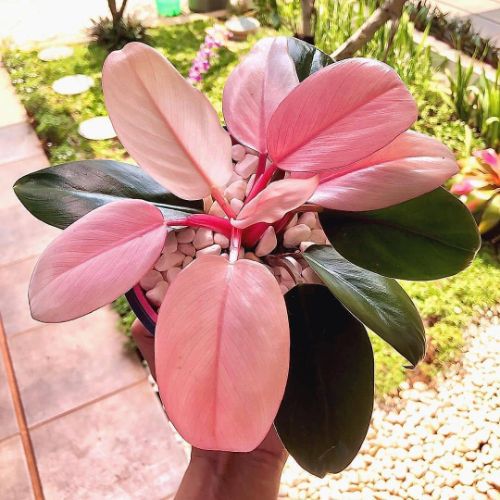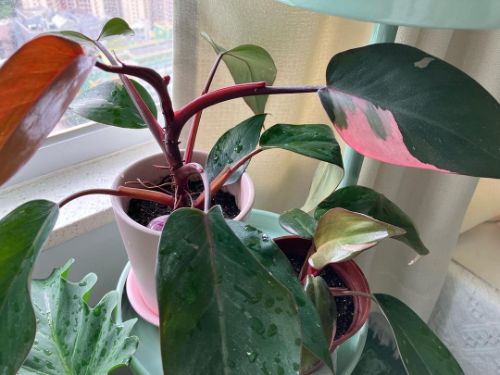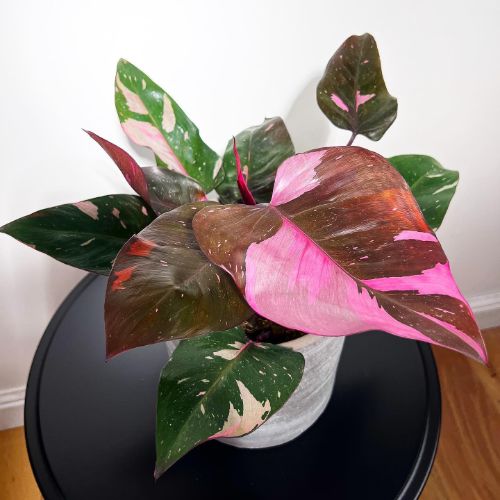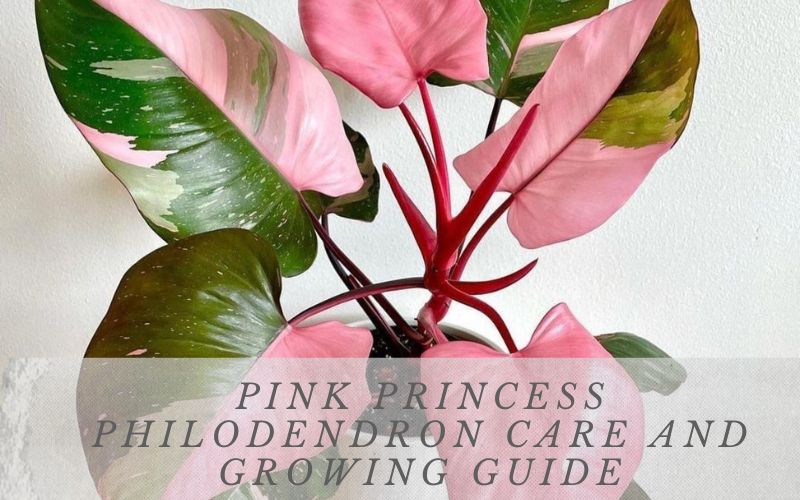Welcome to our full-on guide on Pink Princess Philodendron Care and Growing! Pink Princess Philodendron is a drop-dead gorgeous plant known for its uniquely pink patterned leaves. As a total plant geek, you might have come across this popular plant and wondered how to look after it to keep it healthy and perky.
This blog post will give you all you need to look after Pink Princess Philodendron and growth. From soil and watering requirements to lighting and propagation techniques, we’ll go over all aspects of caring for this stunning plant.
This guide will show you how to take proper care of your Pink Princess Philodendron and see it bloom, whether you are a newbie or a pro plant enthusiast. So let’s start this fun journey into Pink Princess Philodendron Maintenance!
What is a Philodendron Pink Princess?
Philodendron Pink Princess (Philodendron erubescens) is a trailing plant in the Araceae family. Aside from the beautiful pink and dark green leaves, the plant is distinguished by large waxy leaves. These leaves can reach lengths of 9″ (22 cm) and widths of 5″ (12 cm).
A lack of chlorophyll, the chemical that turns plant leaves green, causes pinkness on the leaves. However, some greenness on the leaves is required for the plants to photosynthesize. Chlorophyll contributes to the production of oxygen and glucose, both of which are needed for good growth.
Since Pink Princess Philodendrons are all tropic types, these pink beauties love indoors. If warm enough, you can also plant Pink Princess Philodendron in your garden. Choose a bright but not too sunny spot for the plant to thrive. If you live where it’s not too hot, you can also take your potted plant outside during the summer.
In addition, the Philodendron also has another species called “Pink Congo”.
What is a Philodendron Pink Congo?
If you spot a Philodendron with only pure pink leaves, it’s probably the Pink Congo plant. These plants’ pink hue ain’t a natural thing. The plant gets a chemical shot to make the leaves pink. Pink Congo Philodendron leaves usually turn green half a year to a year after you buy them.
So, if you want to grow a real Pink Princess at home, skip these cheap copies. This way, you’ll always have a cool plant with pink and dark green leaves.

Philodendron Pink Princess Care Quick Overview
| Botanical Name | Philodendron erubescens ‘pink princess’ |
| Common Name | Philodendron pink princess, blushing philodendron |
| Classification | Tropical plant |
| Family | Araceae |
| Hardiness | Zones 9b-11 |
| Mature Size | 2-4 ft. tall, 2-4 ft. wide |
| Soil Type | Loamy, moist but well-draining |
| Soil pH | Acidic |
| Bloom Time | Spring, summer |
| Flower Color | Green, white |
| Hardiness Zones | 9a, 9b, 10a, 10b, 11a, 11b |
| Native Area | South America |
| Temperature | 60-84°F |
| Light | Bright, indirect light indoors, Full to partial shade in outside |
| Watering | Water every 5 to 7 days |
| Humidity | 60-80% |
| Fertilizer | Fertilize 1 times per month |
| Propagation | Stem cuttings |
| Toxicity | Toxic to humans and toxic to pets such as cats and dogs when ingested |
How to Care Pink Princess Philodendron?
Pink Princess Philodendron is a typical houseplant with big shiny leaves and pink veins. This hardy plant handles low light and not watering it often, so it’s easy to look after. Although this plant can take a lot of bad handling, there are some things you gotta remember when caring for your Pink Princess Philodendron.
Light Requirements
The Pink Princess Philodendron, coz it’s from the tropics, needs special light to thrive and keep its enhance color without causing leaf burn. Making sure these light needs are met is key to keeping your plant healthy and good-looking.
Ideal Light Conditions
Pink Princess Philodendrons like a mix of bright and dim sunlight. The trick is to give it enough light to enhance its color without burning the leaves, which is a risk in full sunlight. While this plant can live with less light, it might not look as good. The leaves might shrink, and the vines might look leggy if the light’s too low.
Contrary to some advice, it’s worth mentioning that putting your Pink Princess Philodendron somewhere that gets 4-6 hours of full sun a day may be too harsh for this plant. Instead, filtered or softened light that’s like its natural rainforest home is better and won’t likely hurt the plant.
Locating Your Pink Princess Philodendron
Choosing the right location for your Pink Princess Philodendron is key to meeting its light needs. A north or east-facing window that gets lots of soft sunlight is usually perfect. If you don’t have this, putting the plant near a south or west-facing window, but making sure it’s shielded from full sunlight with curtains or blinds, can also work fine.
Also, rotating your plant every few weeks can make sure all sides get the same amount of light, promoting even growth and stopping the plant from leaning toward the light source.
Supplementing with Artificial Light
If you can’t give enough natural light, artificial lights can help out. Using grow lights can keep it healthy and bright, especially during winter months when daylight is short.

Soil
The perfect potting mix for Philodendron erubescens should have plenty of nutrients and hold moisture without getting too wet. Mix perlite or orchid substrate with peat-based soil to give the best-growing stuff. The other elements enable the drainage of extra water while the rich, organic peat is fertile and keeps it moist.
This type of Philodendron has air roots, like many aroids. They suck nutrients and moisture from the air. Also, philodendron plants have underground roots. Your pink plant can be grown then in a soil-free mix like sphagnum moss or peat-perlite.
These “princesses” need wet soil to do well, despite the fact that they are not picky growers. So, watering right is key to success with this plant species. Try to keep the potting mix wet all the time without it getting too wet or flooded. Fertilize your plant monthly using a half-strength mix of any all-purpose liquid fertilizer during spring and summer. Too much fertilizer will burn leaves, so err on the side of caution.
Watering
The health and growth of Pink Princess Philodendron depend on proper watering. Here are some tips for watering right:
- Frequency of watering: Pink Princess Philodendron needs continuously moist soil, but it’s key to avoid too much water. When the top inch of soil feels dry when touched, water your plant. Depending on how hot or humid it is, you might need to water your plant once or twice a week.
- Use a well-draining potting mix and a pot with drainage holes to stop too much water and let it drain. Until the water runs out from the bottom of the pot, water your plant well. After a couple of minutes, discard any extra water.
- Water quality: Because the Pink Princess Philodendron is sensitive to chemicals, it’s a good idea to use filtered or distilled water to prevent fluoride or chlorine pile-up.
- Avoid using cold water: Cold water can shock the plant and damage the roots, especially during winter.
By sticking to these watering tips, you can make sure that your Pink Princess Philodendron gets the right amount of water for growth and healthy leaves.

Temperature
Pink Princess Philodendron loves rooms with normal temps, making them suitable for indoor growing in most climates. The ideal temp range for this plant is between 60°F and 84°F (16°C – 29°C), with a minimum temp of 55°F (13°C) and a max of 90°F (32°C).
Temps outside of this range can stress out the plant and affect how it grows and its health. Temps below the min range can make the plant go dormant, while temps above the max can burn and wilt the leaves.
It’s important to remember that temp changes can also affect the plant, so it’s best to avoid putting it near drafty windows, doors, or places with big temp changes.
Keeping your Pink Princess Philodendron in a room with a consistent temp in the right range makes sure it grows healthy and bright foliage.
Fertilizer
Fertilizer is key in taking care of philodendron plants like the Pink Princess. Fertilizers give nutrients that are vital for good growth and development, helping your plant thrive and produce beautiful, vibrant foliage.
There are many different types of fertilizers available, each with its own unique formulation designed to meet the specific needs of your plant. When choosing a fertilizer for your Pink Princess philodendron, it is important to consider its growing conditions and particular needs.
Some good choices for feeding this type of plant include organic fertilizers like compost or manure tea, as well as specific houseplant fertilizers that are designed specifically for philodendrons. These fertilizers will provide your plant with the nutrients it needs to stay healthy and vibrant, while also helping to boost strong, lush growth.
In order to get the best results from your fertilizers, it is important to follow the instructions on the pack carefully. Fertilizing too often or using too much of a particular nutrient can hurt your plant, so it is important to be mindful and watch for any changes that may occur.
With regular TLC and the right fertilizer, your Pink Princess philodendron will thrive and continue to amaze you with its beauty and vitality!
Related: Philodendron Selloum Care And Grow: The Ultimate Guide
Humidity
Tropical Pink Princess Philodendrons prefer high-humidity surroundings. Here are some suggestions to help you keep your plant’s humidity at the ideal level:
- The easiest and best approach to bump up the humidity in your home is to use a humidifier. The best humidity range for Pink Princess Philodendron is between 60% and 80%, therefore set the humidifier to that setting.
- Group plants together to create a microclimate that will help to raise the humidity level. The environment gets more humid because of the plant’s transpiration.
- Misting: To bump up humidity levels, mist the leaves of your Pink Princess Philodendron with room-temperature water. Misting should be used in conjunction with other techniques because misting by itself is not enough to keep high humidity levels.
- Use a pebble tray: Fill a tray with water, add a layer of pebbles, and then place your plant pot on top of the water and pebbles. The surrounding air will get more humid as the water evaporation goes up.
You can boost the growth of your Pink Princess Philodendron and avoid problems like yellowing leaves and leaf drops by keeping the ideal humidity level.
Repotting
During its early growth phase, a Pink Princess Philodendron should be repotted every year to boost strong growth. Once the plant grows up, usually after its first few years, how often you repot can be reduced to every two years. Bigger containers give more room for the roots to expand, boost overall plant health, and help with drainage.
Repotting your plant lets you refresh the potting mix while also boosting growth. Bigger containers give the roots more space to grow. Another bonus of repotting is that it keeps the plant’s roots from getting rootbound, which helps drainage.
How should a pink princess be repotted? Because this is one of the priciest houseplants you can grow, you should look after it. Please check out the following guide for repotting a Philodendron Pink Princess:
- Preparation: Before repotting, water your plant thoroughly to help reduce stress and prepare the roots for transplantation.
- Picking a new pot: The new pot should be around 1-2 inches (2.5 – 5 cm) larger than the last one to give space for growth without overwhelming the plant.
- Taking out and Checking: Gently take the plant out from its current pot, getting rid of the old soil from the roots. This is also the time to check the roots for any signs of decay or disease. Healthy roots should look white or light tan, be flexible, and not mushy. If needed, trim the roots that appear diseased or rotten.
- Transplanting: Fill the new pot halfway with a suitable potting mix, preferably one that boosts good drainage. Carefully place the plant in the new pot, making sure the Pink Princess is at the same height as it was in the old pot.
- Finishing up: Fill the remaining space in the pot with more potting mix. Gently press around the base of the stems to give support for the plant, being careful not to harm the stems or leaves.
- Watering: Finally, water the plant well once repotted. This ensures the roots are well-watered and helps the plant adjust to its new environment.

Pruning
Prune Philodendron Pink Princess only in the spring and summer months, when it’s growing actively.
To prune a philodendron plant:
- Start by chopping off any damaged or dead leafy parts from around the plant’s edge. Cut just above where an old leaf joins the stem, using sharp kitchen scissors or a sharp knife.
- Next, remove any shoots or branches that grow out of the plant’s center, chopping them off just above where they pop out from the main stem using sharp kitchen scissors or a sharp knife.
- Finally, trim back any long branches to about half their initial length by cutting them down to the point where they join the main stem.
In general, philodendron green friends need a bit of maintenance, but to keep them looking awesome, prune them about every 3 months during growing periods to remove any dead or damaged leafy parts and branches, and trim back too-long branches.
Pink Princess Philodendron propagation
Propagating Philodendron Pink Princess plants can be a pretty easy job, involving a few different ways.
One of the usual ways is division, where the plant can be split into several parts using a sharp knife or gardening scissors. This can be done either by splitting separate stems or clumps of root, depending on the size and health of the plant.
Another favored way to propagate Philodendron Pink Princess is by cutting off stems, which involves chopping a young, healthy stem from the plant and placing it in a pot filled with a damp soil mix.
You can also get more Philodendron Pink Princess by air propagation, where a stem is bent down near the base of the plant and covered in a moist mix of peat, perlite, and vermiculite.
To propagate Philodendron Pink Princess successfully, it’s key to give your plants lots of sun rays and water regularly. You might also want to consider using top-notch plant food or compost to help boost healthy growth.

Common Pests & Plant Diseases
The Pink Princess Philodendron is a plant kind that adds a nice touch to any home or office. But, it comes with its own issues. The usual pests and sicknesses can attack this beauty and cause big harm, so it’s important to watch out for the following stuff:
- Fungus problems: Fungal diseases, such as botrytis and grey mold, manifest as white, cottony growths on the leaves. A quick move is crucial to stop it spreading and the plant going bad.
- Leaf blight, a usual issue for Pink Princess Philodendrons, can be dealt with by removing the bad leaves and improving air circulation.
- Aphids: Tiny, sap-sucking insects called aphids can cause a great deal of damage to the leaves and stems of your Philodendron Pink Princess. These bugs often show up as small, green, or white specks on the plant’s leaves and stem.
- Scale bugs: A hard-to-spot insect called a scale bug is another pest that can attack your Pink Princess Philodendron. These tiny bugs suck the sap from your plant’s stems and leaves, making them wither up and yellow or brown.
There are many ways to prevent and treat these common pests and diseases. In general, it’s important to keep your Philodendron Pink Princess healthy by giving it plenty of water and nutrients, ensuring the soil is well-draining, and giving it plenty of sunlight.
You can also use bug sprays or pesticides to control these pests if they start to be a pain. And, if you notice fungus growth or other damage, take your plant to a pro for help as soon as you can.
Philodendron Pink Princess Common Problems
Pink Princess Philodendrons can run into usual problems even though they’re a pretty straightforward plant to care for. Here are some troubles you might face and how to sort them out:
- Leaves turning yellow: Overwatering, not watering enough, or bad drainage can all turn your leaves yellow. Make sure the plant isn’t sitting in water, check if the soil’s moist and drains well, and change your watering times as needed.
- Brown leaf tips: Brown leaf tips could point to too much fertilizing or dry air. Try using less fertilizer or up the humidity.
- Pest infestations: Pink Princess Philodendrons are likely to get invaded by scale, mealybugs, and other common houseplant pests. Give your plant a look regularly, and use neem oil or insecticidal soap to treat any bugs.
- Not growing much: If your plant isn’t doing so well, it might be missing out on nutrients or light. Make sure it gets the right amount of light, and fertilize it if needed.
- Leaves falling off: Pink Princess Philodendrons can drop their leaves if they get too much water, get flooded, or get too cold. Be careful with watering and keep it warm and damp.
You can keep your Pink Princess Philodendron happy and growing by keeping an eye on it often and handling any issues right away.

FAQ About Philodendron Pink Princess
Why are Pink Princess Philodendron so expensive?
This type of philodendron is so liked since it’s hard to find, but also really pretty and colorful. However, like many other rare plants, they can get pricey. But if you’re serious about having a pink princess philodendron in your home or greenhouse, the cost shouldn’t put you off.
What is a reverted Pink Princess Philodendron?
A reverted pink princess philodendron is a type of philodendron where the leaves take on more of a green color, with new growth appearing to be more typical for a normal philodendron plant. Unlike other plants that would usually produce flowers, a reverted philodendron produces new leaves that are green instead of pink and it can happen to most types of philodendron, including the pink princess.
Does philodendron pink princess climb?
Yes, a philodendron pink princess can climb, but it will typically only do this if you provide it with some type of support like a trellis or some other structure to help guide its growth. If you don’t give it something to climb on, then the plant may not grow very tall and could instead take on a more bushy appearance. However, if you provide it with something to climb on, then the plant can become quite tall and will be full of beautiful, vibrant leaves.
How to get more pink in philodendron pink princess?
There is no guaranteed way to get more pink in your philodendron pink princess since each plant can have its distinct look. However, some things you can try to encourage the development of more pink leaves include watering and fertilizing your plant regularly, giving it plenty of sunlight, and gradually moving it outdoors once temperatures start to rise in the spring. Additionally, you may want to consider using a pink fertilizer specifically designed for philodendron plants as this can help increase the amount of pink pigment in your plant’s leaves. Overall, with enough care and attention, your philodendron pink princess should produce more pink leaves over time.
Although the Pink Princess Philodendron care can be challenging, it is worth the effort. With a little bit of knowledge and some TLC, your Pink Princess Philodendron will thrive. Be sure to keep an eye on soil moisture levels, water regularly, fertilize occasionally, and provide plenty of humidity and you will be rewarded with a lush, green plant that brings beauty and life to any room. Have you ever cared for a Philodendron? What tips would you add? Please comment for FamiPlants to know.

